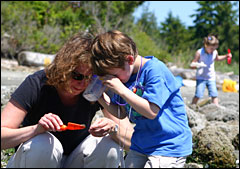“Go outside and play!” It’s a simple enough command, but as a nation of teeth-gnashing parents and teachers will tell you, not enough kids want to unplug or log off long enough to heed it. Enter Congress.
That’s right, Congress.

The oyster is your classroom.
Amid growing evidence that learning about nature and actually experiencing it can help children become healthier, happier, more engaged citizens, Sen. Jack Reed (D-R.I.) and Rep. John Sarbanes (D-Md.) introduced the No Child Left Inside Act in the Senate and House this summer. The goal of the legislation, treading the path forged by author Richard Louv and his acclaimed 2006 book Last Child in the Woods, is to restore environmental education in American classrooms. Such lessons, the evidence shows, can help boost grades across the board, while also preparing students for the myriad challenges ahead: accelerated climate change, pollution, depleted resources, and vanishing flora and fauna, to name a few.
Supporters of the legislation include more than 70 organizations, from the Chesapeake Bay Foundation and the Sierra Club to the Johns Hopkins Bloomberg School of Public Health and the National Education Association. Among the bill’s driving forces is the North American Association for Environmental Education. Grist checked in with Brian Day, executive director of NAAEE, to find out what inspired the bill — and why on earth it matters.
Might as well start off with the rude question: Why do teachers need Washington’s help to get kids outside? Can’t they just shoo them out for recess — mission accomplished?

Brian Day.
Getting children outside is very important, but the bill is about much more than that. In essence, what it would do is provide federal dollars to help train teachers in environmental education and help states create and carry out environmental education plans.
What we aim to do is go back to educating the whole child. We believe children need the whole piece: social studies, history, art, music. And they need to know about the natural world so that they can make good decisions as adults and citizens. We want to make sure that high-school graduates are environmentally literate.
No Child Left Inside is a wink-wink reference, of course, to the No Child Left Behind Act, which hasn’t exactly encouraged the whole child approach. Critics say NCLB has forced teachers to hyper-focus on reading and math. What’s happened to environmental ed in the meantime?
Environmental education is one of many things that got Bushed-out in the No Child Left Behind Act. Teachers have been under so much pressure to prepare children for the mandatory tests in reading and math that they haven’t totally stopped teaching everything else, but they’ve come close. In many schools, looking at environmental issues has virtually disappeared. The budget for environmental education has been almost zero for six years now.
What’s the price tag on No Child Left Inside?
The current version asks for $100 million a year in teacher training — which looks like a fountain of youth for us. It might sound like a lot of money, but you’ve got to look at it in perspective: the state of Maryland alone spends $7 billion a year on education.
Are you aiming to turn millions of schoolkids into enviros?
We really want people to understand this: Environmental education is not about advocacy in the classroom. No Child Left Inside is about helping train teachers and helping children understand the issues. The aim is to help students understand how water systems work, how air pollution systems work, how solid waste and sewage treatment systems work, and how business and other concerns factor in. If we can teach children about physical, human, economic, and living systems, we’ll be enabling them to ask questions and come up with their own solutions. We want them to be able to work within their community on things like where to put a parking lot — or where not to put it, for example, because it might impact a water system. It’s about providing children with good, honest arguments from all angles.
Still, isn’t most environmental education going to be pro-environment?
Some people do come up to me and say, “Oh, I thought you were wanting to train everybody to be a treehugger!” But I say, “No, some of the kids we teach are going to grow up and hug trees, and some of them are going to chop them down.”
Literally? As in, they’ll become loggers?
Some of them might. But a lot of them will grow up and buy houses and other things that require chopping down trees. As environmental educators, we’re just asking that people get the information they need to make responsible choices.
The bill draws on research done by the State Education and Environment Roundtable, a group that’s been studying what happens when schools offer environmental education. According to the results, enviro ed boosts student enthusiasm for learning and improves test scores in reading, writing, math, social studies, and science. Plus, it encourages kids to move around, which fights obesity. Who would want to defeat a measure like that?
So far, knock on wood, we haven’t had any opposition. And we’ve got a lot of people on board. No puns intended.

